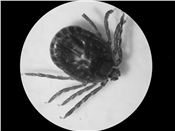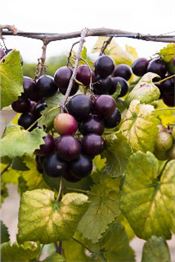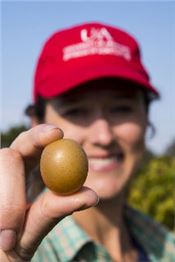Research Shows Hardwood Muscadine Propagation Is Possible For Small Programs
JOHN LOVETT
FAYETTEVILLE, ARKANSAS
Scientists with the Arkansas Agricultural Experiment Station, the research arm of the University of Arkansas System Division of Agriculture, have done what many thought was too difficult to do: root muscadine vines from dormant hardwood stems.
Since 2007, experiment station researchers have propagated muscadines from hardwood stems using a process adapted from a system used with bunch grapes to speed up muscadine breeding at the Fruit Research Station in Clarksville. Muscadines, a type of cluster grape native to the South, are prized for their pest and disease resistance and fruit that is high in antioxidants.
“Conventional wisdom has been that this was impossible because this sub-genus of Vitis is more difficult to propagate with hardwood stems,” said Margaret Worthington, assistant professor of fruit breeding and genetics for the experiment station. “This research shows that institutions with modest muscadine propagation needs like ours can successfully propagate plants from hardwood cuttings.”
Worthington noted most of the topic’s literature is from the first half of the 20th century, and even more recent studies from the 1980s and ‘90s had “very little success using hardwood cuttings.” Most of the varieties in the studies conducted on hardwood propagation in muscadines used in the earlier studies have also been replaced by newer, improved varieties, she added. This project represents the first study on hardwood muscadine propagation in more than 25 years.
Kenneth Buck, a master’s degree student who is the project’s lead author, and Worthington have worked with Patrick Conner, professor of horticulture for the University of Georgia’s College of Agricultural & Environmental Sciences to breed new “fresh market” muscadines for eating and “processing type” muscadines for juice and wine. Their research was funded by a grant from the Southern Region Small Fruit Consortium and Hatch Project. Worthington said the goal is to improve consumer qualities of the grape, as well as cold hardiness, disease resistance and adaptabilities of the vine. She expects to release the new muscadine varieties in the winter of 2023-2024. They will be the first muscadine releases from the Fruit Breeding Program, Worthington said.
It normally takes 10 to 15 years to release a new cultivar of muscadines. The hardwood propagation method demonstrated by Worthington and Buck can cut a year off of that development time.
After making crosses between different cultivars to potentially combine their positive qualities, plant breeders select the best resulting plants to carry forward in the breeding process. With muscadines, breeders must make selections in the late summer or early fall once the fruit is ready to taste. Depending on the location it could be as late as September or October before the fruit is ripe.
With the more conventional muscadine breeding technique of using softwood cuttings – stems that are actively growing – Worthington said breeding programs must wait until the following June to make cuttings of the selected plants for replicated trials. After seedlings shoot out from the softwood cuttings made in June, they must be overwintered in a greenhouse and planted the following spring, nearly two years after being initially selected for trials, she said.
Hardwood cuttings, on the other hand, are taken during the dormant season in the months after the breeder has made selections in the late summer or early fall and put through the rooting process. By the following spring planting season, the hardwood cuttings have had months to establish and can be planted without delay.
Worthington said another common propagation method known as layering requires the same delays as softwood cuttings.
The research and results
Researchers conducted the two-year investigation during the dormant seasons of 2019-2020 and 2020-2021. Hardwood cuttings were taken at the beginning of November, December, January and February. Half of the cuttings were kept for 30 days in cold storage at 39 degrees Fahrenheit before planting, while the other half were planted within 24 hours of collection.
Data on cutting length, diameter, and the number of nodes per cutting were taken 90 days after the cuttings were treated with a rooting hormone and placed in perlite, volcanic glass that has a high-water content, under a mist system in a heated greenhouse.
Worthington said the overall hardwood rooting success rate was 16 percent. Cuttings taken in November generally rooted in higher rates, and increased cutting diameter and cutting length also positively affected rooting success, she said. The muscadine varieties used in the experiment included Carlos, Fry and Supreme.
Worthington said cuttings from the first week of November generally outperformed those taken at other dates likely because the vines were not completely dormant in November. This suggests that taking cuttings before vines before dormancy completely sets in will yield the most success with hardwood cutting propagation, she said.
"The rooting percentages found in the study were not high enough to justify commercial propagation of muscadines by hardwood cuttings," Worthington said. "However, breeding programs, germplasm repositories, or growers with modest needs may find that transitioning to an off-season propagation protocol saves time and money." ∆
JOHN LOVETT: University of Arkansas

Kenneth Buck measures hardwood muscadine cuttings for research conducted as a master's degree student with the Arkansas Agricultural Experiment Station.
U of A System Division of Ag photo

Muscadines grown at the Fruit Research Station in Clarksville have been advanced in breeding trials since 2007 by hardwood propagation. The first releases from the program are expected in the winter of 2023-2024.
U of A System Division of Ag photo

Margaret Worthington, assistant professor of fruit breeding and genetics, shows off a muscadine grape grown at the Fruit Research Station in Clarksville.
U of A System Division of Ag photo